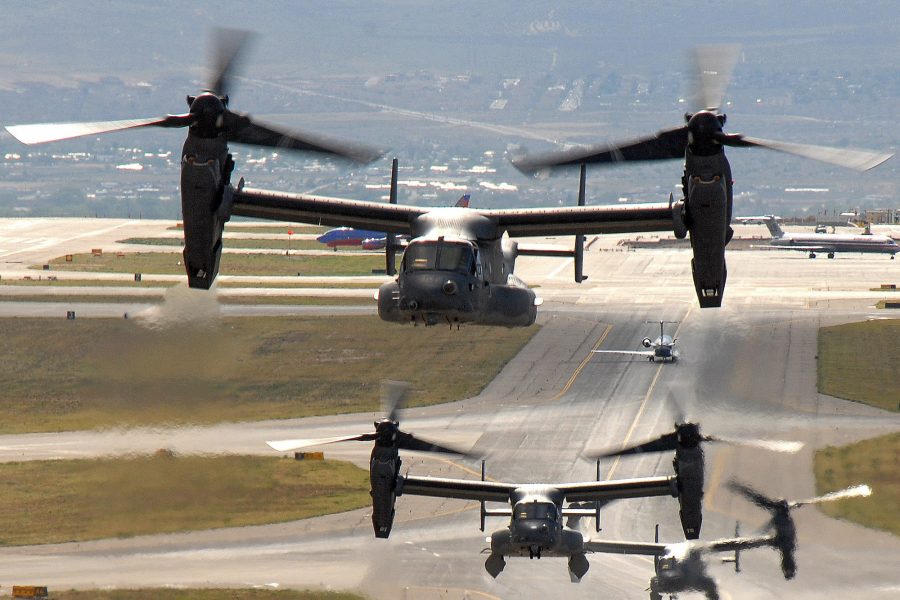The CV-22 is a medium-lift, vertical takeoff and landing (VTOL) tiltrotor, primarily used for clandestine long-range, all-weather penetration to insert, recover, and support SOF teams in hostile, denied, and politically sensitive areas.
Derived from the V-22, which flew in prototype form on March 19, 1989, USAF CV-22Bs are equipped with a fully integrated precision TF/ TA radar navigation, digital cockpit management system, FLIR, integrated NVG/HUD, digital map system, robust self-defense systems, and secure antijam comms. The CV-22 can conduct shipboard and austere forward operations and is USAF’s sole high-speed vertical lift asset. It is also fully capable of operating in nuclear, biological, and chemical (NBC) warfare conditions.

CV-22s first deployed to Africa in November 2008 and debuted in combat in Iraq in 2009. The Department of the Navy leads joint-service sustainment with USAF funds, while SOCOM foots special operations specific mods. The program is currently retrofitting CV-22s to Block 20 standard, in common with USMC’s MV-22s. Mods include new cabin lighting, Color Helmet Mounted Displays, IR searchlight, lightweight ballistic armor, EW upgrades, avionics, self-defensive improvements, weapons integration, and ISR and situational awareness enhancements.
USSOCOM is replacing the CV-22’s legacy APQ-186 radar with the Silent Knight TF/TA radar (in common with the MC-130J) under a three-year contract awarded in FY21.
A CV-22 test-flew the stealthier, low-altitude, night/all-weather navigation radar for the first time in 2020 and FY24 funds retrofit a second test aircraft to support full fielding. Priority modifications include improving the Osprey’s rapid, long-distance self-deployment capabilities, modifying its nacelles to improve maintainability, improving engine IR suppression, and reducing dust/debris ingestion.
Airborne Mission Networking (AbMN) will eventually give the aircrew a common air/ground picture and manage complex workloads (in common with the AC/MC-130 fleet), and TacNet will add lightweight Link-16. The Pentagon grounded all V-22 variants for three months following the crash off the coast of Japan which killed eight USAF personnel on Nov. 29, 2023.
AFSOC previously grounded the fleet in 2022 due to engine-gearbox issues affecting controllability and cited material failure as the primary cause of the most recent crash. The joint service fleet returned to flight March 8, 2024, and AFSOC plans to take a phased approach to resuming full operations on top of previously implemented training and procedural changes. FY24 additionally funds gearbox, clutch, and proprotor safety improvements. USAF is considering using the CV-22 as an interim long-range CSAR platform to augment the HH-60W in the Pacific region.
Contractors: Boeing; Bell Helicopter Textron.
First Flight: February 2000 (CV-22).
Delivered: Sept. 19, 2005-present.
IOC: 2009.
Production: 54 (planned).
Inventory: 52.
Operator: AETC, AFSOC, ANG (associate).
Aircraft Location: Cannon AFB, N.M.; Hurlburt Field, Fla.; Kirtland AFB, N.M.; RAF Mildenhall, U.K.; Yokota AB, Japan.
Active Variant: •CV-22B. Air Force special operations variant of the V-22 Osprey.
Dimensions: Span 84.6 ft, length 57.3 ft, height 22.1 ft, rotor diameter 38 ft.
Weight: Max vertical T-O 52,870 lb; max rolling T-O 60,500 lb.
Power Plant: Two Rolls-Royce-Allison AE1107C turboshafts, each 6,200 shp.
Performance: Cruise speed 277 mph, combat radius 575 miles with one internal auxiliary fuel tank, self-deploys 2,100 miles with one in-flight refueling.
Ceiling: 25,000 ft.
Armament: One ramp-mounted .50-caliber machine gun. Planned: One belly mounted forward firing GAU-17 (modified) 7.62 mm minigun Fullazimuth Defensive Weapon System (FDWS).
Accommodation: Two pilots, two flight engineers.
Load: 24 troops seated, 32 troops on floor, or 10,000 lb cargo.
